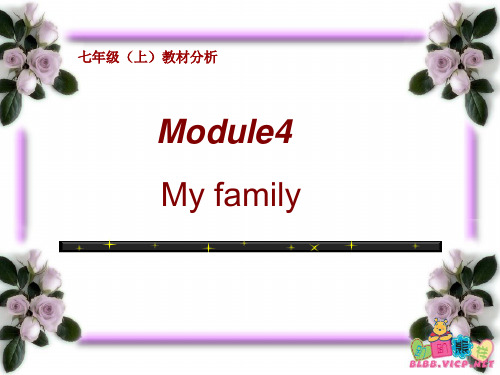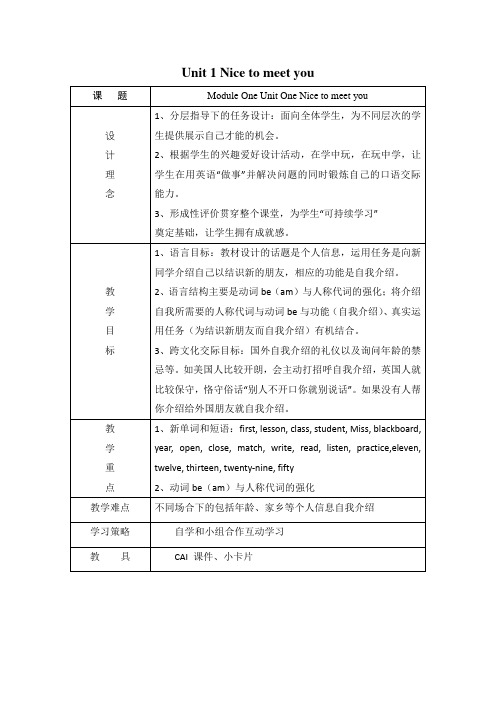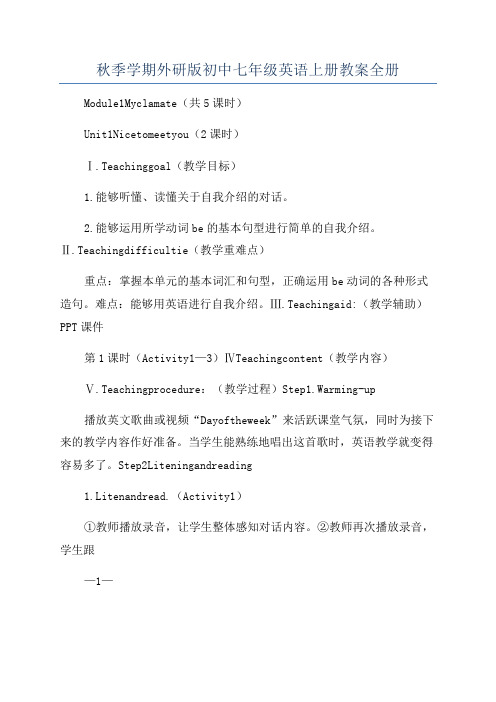外研版七年级英语上册Module 4 Unit 3教案
外研版英语七年级上第四模块教材分析

教学重点、 四.教学重点、难点 教学重点
教学重点: 教学重点:
Key vocabulary—email, him, have got, uncle Key structures---there is/are… I have got…
教学难点: 教学难点:
have/has got 和there be 句型的区别。 句型的区别。
5. small 与 little 区别 都含有“ 的意思。 主要强调形状、 (1)small和little 都含有“小”的意思。但small主要强调形状、面积等小, ) 和 主要强调形状 面积等小, 它不含有任何的感情色彩。 它不含有任何的感情色彩。 Eg: The box is too small. 这个盒子太小。 这个盒子太小。 主要指年龄小,含有很强的感情色彩, (2)little 主要指年龄小,含有很强的感情色彩,主观上表示对人或某种小 ) 动物含有喜爱之意。 动物含有喜爱之意。 Eg: The little girl is Mr Wang’s daughter. 那个小女孩是王先生的女儿。 那个小女孩是王先生的女儿。 6. Thank you for your email. 谢谢你的电子邮件。 谢谢你的电子邮件。 短语: 短语:Thank you for… 剖析: 表示……而感谢你。” 介词 而感谢你。 介词for 后可以接名词、代词或动词的 后可以接名词、代词或动词的-ing 剖析: “表示 而感谢你 形式。其另一种表达方式是Thanks for…。 形式。其另一种表达方式是 。 Eg: Thanks/Thank you for helping me. 谢谢你对我的帮助。 谢谢你对我的帮助。 thanks for 与thanks to的区别 的区别 因某事而感激某人” 表示对对方的行为表示感谢。 (1)thanks for 是“因某事而感激某人”,表示对对方的行为表示感谢。 ) 则表示“由于,多亏” (2)thanks to 则表示“由于,多亏”,其中的介词短语在句中作原因状 ) 常位于句首。 语,常位于句首。
外研版七年级英语上册教案全集

Unit 1 Nice to meet you教学流程图: 教学步骤 l (1课时)一、第一教学环节:情景创设、布置任务、激趣导入二、第二教学环节:师生互动、培养能力、给予成就感三、第三教学环节:评价总结、激发竞争、巩固提高附:评价表(小组成员之间进行评价,以星号为标记,五个星为最高,但是必须小组全票才能通过生效)Unit 2 I’m from China and I’m ChineseTeaching aimKnowledge: *useful expressions in introducing and greeting*nominal genitive pronoun & determinative genitive pronounAbilities: To be able to introduce oneself and others and greet peopleMoral education:To build up students’ confidence and interest in English- learning Key points: Introducing othersThis is Betty. This is my friend, Tony.Difficult points: 1) Asking for and receiving personal information.What’s your nameCan you introduce yourself please, BettyI’m from America. I’m 13 yea rs old.2) To master the names \ languages\ of some countriesTeaching methods: Group work, displayTeaching aids: Computer recorderTeaching procedures:Step 1 Teacher’s self-introduction (Lead-in)Name, Country, language, Age otherKey Sentence Structures:My name is ##.My first name is ##.My telephone number is ##.I’m from ##. I ‘m ##.My age is a secret.I am from Beijing. I come from Beijing. I am a native in Beijing.I come from China. I was born in China and brought up in China. I speak Chinese. In my spare time, I enjoy ###.My E-mail Address is ##.Step 2 Foreign teacher’s introduction (The same)This is our foreign teacher. (Name, Country, language, Age other) Students’ Activity: Listen and get some informationStep 3. The stud ents’ IntroductionNameAgeTeacherYearClassPhone numberE-mail addressCountryLanguageOtherListen and prepare the introduction.Introduce themselves according to the form.Pair work; Introduce themselves.Step 4. Part 2 on the book.Please listen to the tape so that we can know more about Daming, Lingling and Wang Hui. Please don’t open your books. Look at the blackboard.Listen and Answer.:1)Where is Daming from2)Where is Lingling from3)Where is Wang Hui from4)How old are theyName Country Language Age OtherBettyTonyLinglingWork in pairs to practise the dialogue.Students’activity: Listen to the tape; Practise their listening; Improve their abilities of get informationStep 5. Learning the dialogue.Practise the listening skill & Role playStudents’ activity: According to the form, they work in groups to practise the dialogue.Step6. Show a map of the world to practise the names \ languages of the countries Listen and think so many foreign countries’ names.Step7. Read aloudThe students read aloud to practise oral English.Write some sentences about the pictures.Step9. Learning the language item.1)My name’s … /I’m from…/He’s fourteen years old.2)The names of the countries.The students learn the language points.Homework: Introduce one of your pen-friends.Unit 3 Language in use学习目标:1.学习be动词的简单用法。
外研版英语七年级上册Module 3教案

外研版英语七年级上册Module 3教案Book1 Module 3 My school一、教学内容:Unit1 There are thirty students in my class.二、课型:Listening and speaking三、教学目标:1、能正确运用本单元的词汇及短语:computer, furniture, map, picture, television, wall, thirty, forty,fifty, sixty, seventy, eighty, ninety, really, many, howmany, there, a lot of, any, world 。
2、能听懂介绍学校的简单对话。
3、能掌握“there be”句型的肯定、否定、一般疑问及特殊疑问句式和相应回答.并能运用此句型来介绍自己教室的样子。
4、能向同学们描述自己理想的教室的样子,如对自己理想教室的样子的设想等。
四、教学重难点:掌握“there be”句型的肯定、否定、一般疑问及特殊疑问句式和相应回答.并能运用此句式来介绍自己教室的样子。
五、教学准备:本课指导学生通过听力获取信息,培养学生听力技能。
课堂上采用多媒体手段辅助教学,在轻松愉快的氛围中,在较真实的语境下,并联系学生生活实际,结合已有的知识和经验,运用所学的语言基础知识自我学习、互相学习,让学生在语言实践中相互启发、生成,体验成功。
培养学生的合作精神,发展其思维和想象等能力。
在教学过程中,采用多媒体手段辅助教学,利用各种图片和习题任务贯穿整个教学过程。
因此,本节课需准备:PPT课件、挂图、录音机、课堂练习表格、奖品。
六、预习要求:根据音标自学本课新单词;七、教学过程:教学步骤教师活动学生活动设计意图Step On e Warming -up (3’)Lead in1.Free talk:(1)Show some pictures and ask Ss like these:What’s in the picture?Is/Are there …?What’s in the classroom?There is/are …(2)Show more pictures and let Ss talk about them and learn some new words, try touse the sentences with “There is/are….”1. Answer thequestions.2. Talk with partners, learn some new wordsand try to use the sentences with “There is/are...”让学生在free talk的过程中感受新的语言项目,通过这个环节,既可以活跃课堂气氛,还调动了学生的学习兴趣。
外研版七年级上册英语 Module 4 Unit 3 Language in use

33. Fromtheform, youcangettheinformationof_______.A A. thepriceB. theaddress C. thetelephonenumberD. thenameofsoup
4. Thereissome______C__inthebottle(瓶子), andtherearesome________inthebag.
A. orange; orange
B. oranges; oranges
C. orange; orangesD. oranges; orange
【点拨】orange作“橙汁”讲, 是不可数名词, 作 “柑橘”讲, 是可数名词。
外研版七年级上
Module4Healthyfood
Unit3Languageinuse
习题链接
温馨提示:点击 进入讲评
1D
题组专训•突破考点
答案呈现
6 adressfor
2 Have; gotany 3A
4C
5 buysome
习题链接
1 bananas
课后巩固•拓展延伸
答案呈现
6 A 11 haven't; any
答案呈现
习题链接
课后巩固•拓展延伸
21 important
26 bad
22 healthy
27 children
23 for
28 well
24 bread
29 get
25 or
30 some
七年级英语上册Module4教案外研版

七年级英语外研版(上)学案Module 4 My family一、学习目标:1.单词和短语:many , people , aunt , grandfather , grandmother , grandparent , uncle , have got , email , him2.交际用语:1) How many people are there in your family ? 你们家有多少人?2) Thank your for your email . 谢谢你的电子邮件。
3) We’ve got a small family . 我们有个小家庭。
4) — Have you got any brother ? 你有兄弟吗?— Yes , I have . / No , I haven’t . 是的,我有。
/ 不,我没有。
5) He hasn’t got any brothers . 他没有兄弟。
3. 语法:have / has got 的用法。
二、重点及难点:there be 与 have/has , have /has got 的区别三、学习步骤:Unit 1 How many people are there in your family ? 一)自主学习A. 写出一组你能够想到的关于家庭成员的词汇(至少10个)____________________________________________________________________________________________________________________________________________________________________________________________________________________________________________________________________ Answers:father , mother , brother , sister , uncle , aunt , grandfather , grandmother , parents , grandparents , grandson , granddaughter , wife , husbandB .Look at the pictures . Label Tony’s family .aunt , brother , father , grandfather , grandmother , grandparents , mother , parents , sister , uncleAnswers:1. grandmother2. grandfather3. grandmother4. grandfather5. uncle6. aunt7. mother8. father9. uncle 10. sister二)知识点学习1. family home和house的区别1) family的意思是“家庭、家庭成员”,与居住的房子无关。
外研版英语七年级上册Unit 3 教案

Module 7 ComputersUnit 3 Language in use 课型Revision and application教材分析本单元是一个练习单元,是通过练习和活动,对学生在本模块一、二单元中所学的电脑方面的基本词汇、一般现在时的特殊疑问句和答句等知识进行复习和巩固,使学生能更为透彻地理解、更为准确运用所学知识。
语言知识目标1.语法:复习巩固一般现在时的用法,尤其是本模块所学的一般现在时特殊疑问形式2.词汇:①生词:holiday②复习本模块所学的有关电脑方面的词汇语言技能目标1.听:能听懂所学的有关电脑方面的词汇;听懂一般现在时的特殊疑问句2.说:能就电脑的使用进行简单的问答;能运用一般现在时特殊疑问形式进行问答3.读:能读懂简单的特殊疑问句及其回答4.写:能结合本模块所学的语言知识,准确运用所学句型结构写出相关的表达学习策略目标1.认知策略:联系、归纳、推测等技能。
如能通过观察、应用,总结归纳出一般现在时特殊疑问句的用法2.调控策略:从同伴处得到反馈,对自己在叙述及书写中的错误进行修改3.合作学习策略:同学之间互相学习,取长补短文化意识目标了解不同国家和地区的人们使用电脑的情况情感态度目标通过学习电脑方面的词汇提高对英语的学习兴趣任务设计一个有关电脑方面的问卷教学重点1.复习巩固一般现在时的用法,尤其是本模块所学的一般现在时特殊疑问形式2.复习巩固本模块所学的电脑词汇及一些动宾搭配的使用。
教学难点较熟练地运用本模块中所学的词汇和句型,区别应用助动词do, does教学方法任务教学法教学设备录音机;多媒体课件教教学步骤设计意图教师活动学生活动Step 1Warming-up对本模块所学的有关电脑的词汇进行复习,在复习过程中调动学生的学习积极性。
强化对词汇及一些动宾搭配的理解、记忆和掌握,为任务的开展做好词汇的储备。
1.Greetings.2.Review the words.1) I can see pictures and information onit.(screen)2) Ican use it to print my homework.(printer)3) I can type information into the computer.(keyboard).4) I can click it and open a new document.(mouse). What are they?3. Show some pictures to review the text ofUnit 1 and Unit 2.1. Greetings2. Guessing.3. Look at thepictures, andanswer theteacher’s questions.学过程Step2Languagepractice复习一般现在时疑问句句式。
统编外研版七年级英语上册优质课件 Starter Module 4 Unit 3

3 Listen and read.
Tony: What’s your favourite sport, Daming? Daming: Football!
Tony: It’s my favourite sport too! Daming: Let’s play football after
school. Tony: OK. Good idea!
New words
basketball football
swimming table tennis
sport let
n. 篮球 n. 足球 n. 游泳 n. 兵乓球 n. 运动 v. 让,使
us let’s =let us
play
after school
idea
pron. (宾格)我们 让我们 v. 参加(体育运动或
2) “play+球类名词”表示进行某项球类运 动,注意该短语中球类名词前不加冠词 a/an/the。 play basketball 打篮球 play table tennis 打乒乓球
3. Good idea! 好主意! Good idea!常用来表示支持或赞同别人 的建议或看法,也可以说That’s a good idea! — Let’s go swimming on Friday. 让我们星期五去游泳吧。
Starter Module 4 My everyday life
Unit 3 What’s your favourite sport?
外研·七年级上册
1 Listen and repeat. 1. basketball
2. football
3. swimming
4. table tennis
秋季学期外研版初中七年级英语上册教案全册

秋季学期外研版初中七年级英语上册教案全册Module1Myclamate(共5课时)Unit1Nicetomeetyou(2课时)Ⅰ.Teachinggoal(教学目标)1.能够听懂、读懂关于自我介绍的对话。
2.能够运用所学动词be的基本句型进行简单的自我介绍。
Ⅱ.Teachingdifficultie(教学重难点)重点:掌握本单元的基本词汇和句型,正确运用be动词的各种形式造句。
难点:能够用英语进行自我介绍。
Ⅲ.Teachingaid:(教学辅助)PPT课件第1课时(Activity1—3)ⅣTeachingcontent(教学内容)Ⅴ.Teachingprocedure:(教学过程)Step1.Warming-up播放英文歌曲或视频“Dayoftheweek”来活跃课堂气氛,同时为接下来的教学内容作好准备。
当学生能熟练地唱出这首歌时,英语教学就变得容易多了。
Step2Liteningandreading1.Litenandread.(Activity1)①教师播放录音,让学生整体感知对话内容。
②教师再次播放录音,学生跟—1—读、模仿。
③学生两人一组练习对话。
④教师让不同的小组展示对话,关注学生的发音。
2.Litenandrepeat.Nowpoint,akandanwer.(Activity2)①教师放录音,学生听录音。
②教师再次播放录音,学生跟读、模仿。
③学生两人一组根据日历练习对话。
④教师让部分小组展示对话。
环节说明:本活动以日历的形式让学生学习表示星期一至星期日的7个词汇,然后指着日历上的具体日期来询问星期几,进而练习相关句型“Whatdayiittoday”教师向学生说明在西方国家Sundayithefirtdayoftheweek,让学生了解这种文化差异。
Step3Practice1.Readandmatch.Nowlitenandcheck.(Activity3)①学生个体活动,完成匹配。
- 1、下载文档前请自行甄别文档内容的完整性,平台不提供额外的编辑、内容补充、找答案等附加服务。
- 2、"仅部分预览"的文档,不可在线预览部分如存在完整性等问题,可反馈申请退款(可完整预览的文档不适用该条件!)。
- 3、如文档侵犯您的权益,请联系客服反馈,我们会尽快为您处理(人工客服工作时间:9:00-18:30)。
Module 4 Healthy foodUnit 3 Language in use教学目标【知识与技能】1. 掌握本模块的单词和短语2. 熟练运用have/has got句型。
3. 能在句子中正确使用some, any。
4. 正确区分可数名词与不可数名词,并能正确使用可数名词的复数形式。
5. 能够运用所学的知识发表自己对食品的看法,在同学之间进行真实的交际。
【情感、态度与价值观】让学生学会区分健康食品与垃圾食品,培养学生形成良好的饮食习惯,拥有强健的体魄。
教学重难点【教学重点】1. 能够运用所学的知识发表自己对食品的看法。
2. 能够制作食品海报并进行展示。
【教学难点】1. 能够运用所学的知识发表自己对食品的看法。
2. 能够制作食品海报并进行展示。
教学过程Step 1 RevisionReview the text of Unit 1 and Unit 2 .Step 2 Language practice1. Read through the example sentences in the box with the whole class .2. Ask the students to repeat the sentences in the box.3. Grammar : …have /has got some……haven’t /hasn’t got any…Have / Has … got any…?Step 3 Work in pairs1.Ask the students to work in pairs and to talk about the fridge.— Have we got any meat in the fridge?— Yes , we have.— Have we got any…?—Yes, we have. / No, we haven’t.2. Write about the fridge in the picture with have got some and haven’t got any .3. Call back the answers from the whole class, check the answers.Answers :1. have got some2. haven’t got any3. haven’t got any4. have got some5. have got some6. have got some7. haven’t got anyStep 4 Look at the picture in Activity 2 and talk about it.1. Ask the students to read the words in the box.2. Look at the picture carefully.3. Talk about like this:He has got some a(n)…He hasn’t got any…She has got some a(n)…She hasn’t got any…They have got some a(n)…They haven’t got any…Step 5 Complete the word map.1. Ask the students to complete the word map individually, then check with a partner.2. Call back the answers from the whole class, check the answers.Step 6 Complete the sentences with the words from the box.1. Ask the students to read through the sentences.2. Complete the sentences with the words from the box.3. Ask the students to check with a partner.4. Call back the answers from the whole class.Keys:1. Remember 2. important 3. stay 4. delicious 5. bitStep 7 Grammar.名词的复数A) 构成方法及读音规则1) 一般情况加–s:map-maps boy-boys girl-girls pen-pens bag-bags car-cars清辅音后读/s/ 浊辅音和元音后读/z/2) 以s, sh, ch, x等结尾加–es, 读/iz/bus-buses watch-watches box-boxes brush-brushes3) 以辅音字母+y结尾,变y 为i再加es, 读/z/baby---babies city-cities country-countries但以y结尾的专有名词,或元音字母+y 结尾的名词变复数时,直接加s变复数。
例如:two Marys the Henrys monkey---monkeys holiday---holidays4) 以o结尾的名词,变复数时:a. 加s,如:photo— photos piano—pianosradio—radios zoo—zoos;b. 加es,如:potato— potatoes tomato—tomatoes5)以f或fe 结尾的名词变复数时:改f, fe 加ves,如:half—halves knife—knives leaf—leaves wolf—wolveswife—wives life—lives thief—thieves;B) 名词复数的不规则变化1) child—children , foot—feet, tooth—teeth mouse—mice,man—-men ,woman—women注意:由一个词加man 或woman构成的合成词,其复数形式也是-men 和-women,如an Englishman,two Englishmen。
但German不是合成词,故复数形式为Germans;Bowman是姓,其复数是the Bowmans。
2)单复同形,如deer,sheep,fish,Chinese,Japanese ,li,jin,yuan,two li,three mu,four jin等。
但除人民币的元、角、分外,美元、英镑、法郎等都有复数形式。
如:a dollar, two dollars; a meter, two meters。
3)集体名词,以单数形式出现,但实为复数。
例如:people police cattle 等本身就是复数,不能说a people,a police,a cattle,但可以说a person,a policeman,a head of cattle.4)以s结尾,仍为单数的名词,如:a. maths,politics,physics等学科名词,一般是不可数名词,为单数。
b. news 为不可数名词。
c. the United States,the United Nations 应视为单数。
The United Nations was organized in 1945. 联合国是1945年组建起来的。
5)表示由两部分构成的东西,如:glasses (眼镜)trousers,clothes等,若表达具体数目,要借助数量词pair(对,双);suit(套); a pair of glasses; two pairs of trousers等。
6)另外还有一些名词,其复数形式有时可表示特别意思,如:goods货物,waters 水域,fishes(各种)鱼。
C) 不可数名词:不可数名词主要分物质名词和抽象名词。
1) 物质名词是指表示无法分为个体的实物的词,常见的物质名词,如:snow(雪),rain(雨), water(水),coffee(咖啡), tea(茶), meat (肉), milk(牛奶), rice(米饭), bread(面包), orange (桔汁), beef (牛肉), chicken(鸡肉) , juice (果汁), pork(猪肉) , Coke (可口可乐), ice cream (冰激凌) 等;2) 抽象名词是指表示动作、状态、品质、感情等抽象概念的词,常见的抽象名词,如:work(工作), study(学习), love(爱), friendship (友谊)等。
Step 8 Around the world : A Western breakfast.1. Ask the students to look at the picture and discuss what they can see.2. Read through the information with the whole class.Step 9 Module task: Making a poster about a healthy breakfast.1.Work in groups of four or five. Make a poster about a healthy breakfast.2. Present your poster to the class. Talk about it with your classmates.HomeworkWrite a passage to introduce your eating habits.教学反思。
